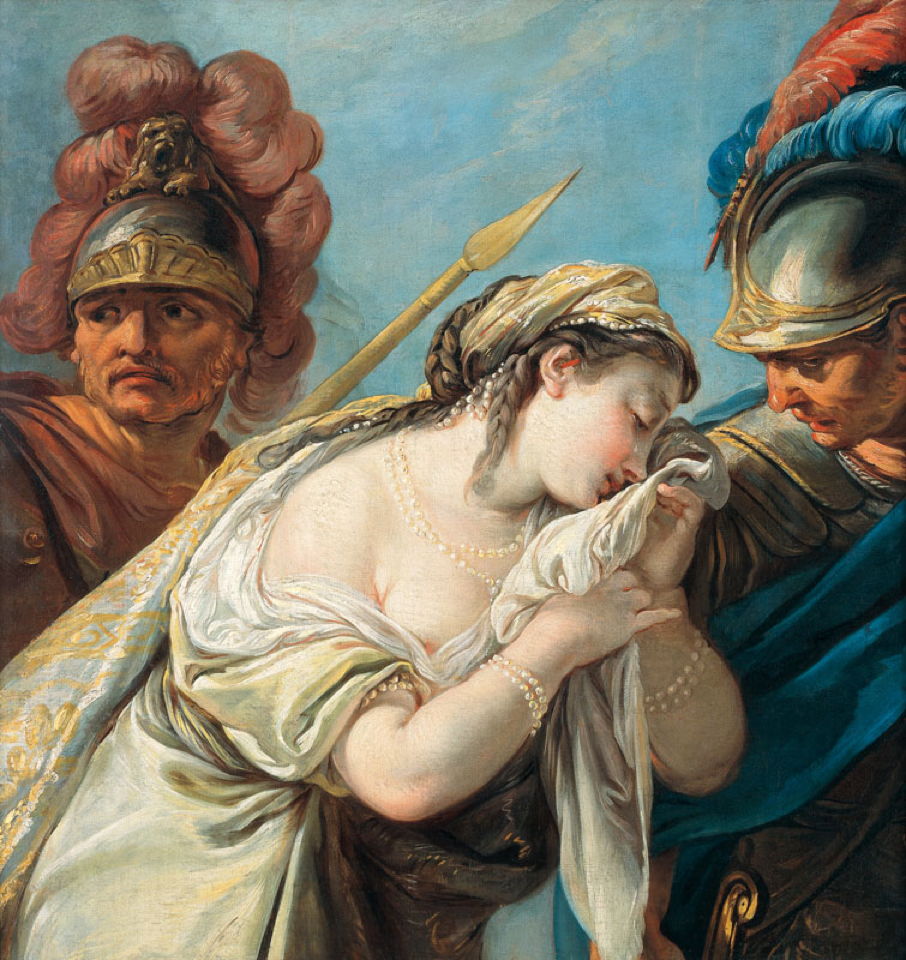Heroines 3: The anger of Achilles and the faithfulness of Briseis

Homer opens the Iliad not with lines about Helen, Paris or the war against Troy, but telling of the anger of Achilles, son of Peleus:
The wrath of Peleus’ son, the direful spring
Of all the Grecian woes, O Goddess, sing!
(Alexander Pope’s translation (1715-20), via Wikisource.)
Once away at war, Achilles justified his reputation as Agamemnon’s best warrior and finest leader. During an assault on the city of Lyrnessus in an earlier phase of the war, Achilles killed the local king, queen, their three sons and a son-in-law, leaving the king’s daughter as sole survivor. As was usual at the time, the warrior took that widowed princess Briseis as his enslaved concubine.
By this stage, Agamemnon, despite his marriage to Clytemnestra, had also won himself a concubine in Chryseis, daughter of Chryses, a priest of Apollo. Chryses was left alive, though, and tried to ransom her back. When Agamemnon refused to bargain with his concubine’s father, Apollo sent the plague to sweep through the massed Greek forces, with devastating effect. This forced Agamemnon’s hand, and Chryseis was promptly returned to her father.
It’s here that the Iliad opens, with Agamemnon’s decision that he should take Briseis from Achilles, to make her his own in place of Chryseis. Abhorrent by any modern standards, women captured during war and in other circumstances were treated as prize possessions, and Agamemnon’s actions were by no means exceptional.
Although Briseis was but a slave and concubine, there’s evidence of a deeper relationship developing. Achilles’ close friend Patroclus had comforted her following the loss of her home city, family and freedom, and promised to have Achilles make Briseis his wife when the war was over. The arrival of Agamemnon’s two envoys, Eurybates and Talthybius, to take Briseis to Agamemnon therefore came as a shock to Achilles, Patroclus, and Briseis.
Jean Auguste Dominique Ingres (1780–1867), Achilles Receiving the Envoys of Agamemnon (1801), oil on canvas, dimensions not known, École nationale supérieure des Beaux-Arts, Paris. Wikimedia Commons.
In 1801, JAD Ingres’ painting of Achilles Receiving the Envoys of Agamemnon won the young artist that year’s Prix de Rome, and launched him on his career as a great history painter. The two envoys are at the right, explaining Agamemnon’s demand to Achilles at the left, who is clutching his lyre as he rises from his seat in anger. Patroclus stands behind him, wearing his helmet and a look of bemusement.
Jean Auguste Dominique Ingres (1780–1867), Achilles Receiving the Envoys of Agamemnon (detail) (1801), oil on canvas, dimensions not known, École nationale supérieure des Beaux-Arts, Paris. Wikimedia Commons.
This detail shows Achilles and Patroclus in the foreground, and behind, in Achilles’ tent, stands Briseis. As a non-Greek, she must have found it difficult to understand the conversation going on with the envoys, which was perhaps just as well.
Johann Heinrich Wilhelm Tischbein (1751-1829), Briseis Led from the Tent of Achilles (1773), oil on canvas, dimensions not known, Hamburger Kunsthalle, Hamburg, Germany. Image via Myth’Arts, origin unknown.
Tischbein’s painting of Briseis Led from the Tent of Achilles (1773) makes the removal of Briseis from Achilles’ tent look more amicable. By any account, it was far from that.
John Flaxman (1755–1826), Briseis Taken from Achilles (c 1793-1805), media and dimensions not known, illustration for Pope’s translation of The Iliad (?1805), location not known. Wikimedia Commons.
John Flaxman’s original drawing of Briseis Taken from Achilles, made between about 1793-1805 to illustrate Pope’s translation of the Iliad perhaps, catches the atmosphere better as Achilles sulks in anger, and Patroclus tries to comfort Briseis again.
John Flaxman (1755–1826) engraved by Tommaso Piroli (c 1752–1824), Briseis Taken from Achilles (1793), engraved print, illustration for Pope’s translation of The Iliad, Book 1, lines 354-358 (1795), Private collection. Image by H.-P.Haack, via Wikimedia Commons.
Piroli’s final engraving of Flaxman’s illustration, Briseis Taken from Achilles (1793), shows an oddly weaker composition and feeble body language.
Jean-Baptiste-Henri Deshays (1729–1765), Briseis Led from the Tent of Achilles (c 1761), oil on canvas, 83 x 78.5 cm, Musée des Augustins de Toulouse, Toulouse, France. Wikimedia Commons.
Jean-Baptiste-Henri Deshays’ Briseis Led from the Tent of Achilles (c 1761) is a close-cropped view of the grief of Briseis as she is led away by the envoys, in an interesting change of focus from Achilles.
George Frederic Watts (1817-1904), Achilles and Briseis (c 1858-60), fresco of mixed media and oil on plaster, 122 x 518.5 cm, Watts Gallery, Compton, England. The Athenaeum.
George Frederic Watts showed an alternative version in his much later fresco of Achilles and Briseis (c 1858-60). Achilles is once again the centre of attention, and being comforted by another woman, as Patroclus, further to the left, looks resigned to events.
Giovanni Battista Tiepolo (1696–1770), Eurybates and Talthybius Take Briseis, Achilles’ Concubine, to Agamemnon (1757), fresco, dimensions not known, Villa Valmarana, Vicenza, Italy. Wikimedia Commons.
Tiepolo told the story over three sections of fresco in the Villa Valmarana, Vicenza, in 1757. In the last of them he shows the scene as Eurybates and Talthybius Take Briseis, Achilles’ Concubine, to Agamemnon.
The Iliad continues its focus on Achilles and his anger, resulting in the warrior withdrawing completely from the action. This was devastating to the Greek campaign, and as Achilles’ anger simmered steadily over the following days, the Trojans started to gain the upper hand. Agamemnon knew he had to persuade Achilles to re-engage if the Greeks were going to have any chance of success. He tried offering Achilles wealth as compensation for the loss of Briseis, and a deputation of Ulysses, Ajax, and Phoenix was sent to appease Achilles’ wrath, but failed.
It was about this time that, according to Ovid’s fictional account in the third letter of his Heroines, Briseis might have written to Achilles. Whereas much of Homer’s Iliad is devoted to describing Achilles’ side of the story, Ovid takes up the cause of his former concubine, then presumably sharing Agamemnon’s bed.
Robinet Testard (fl. 1470-1531), Briseis Writing to Achilles (c 1510), miniature in Héroïdes ou Epîtres, by Ovid, translated by Octavien de Saint-Gelais, Bibliothèque nationale de France, Paris. Wikimedia Commons.
Robinet Testard’s miniature Briseis Writing to Achilles (c 1510) shows this, in Octavien de Saint-Gelais’ translation of the Heroides into French. Briseis weeps as she struggles to write to her former captor in a foreign language.
Ovid’s fictional letter goes over the horrific murders of both her parents, her three brothers, and her husband. Despite those, Briseis even offers to remain Achilles’ concubine if he were to marry another woman. She pleads with the warrior to take her back and settle with Agamemnon. She also swears that she hasn’t slept with Agamemnon, although she doubts that Achilles has been faithful to her since their parting.
The anger of Achilles wasn’t assuaged. Eventually, his dear friend Patroclus went out to fight wearing Achilles’ famous suit of armour, and was mortally wounded.
Léon Cogniet (1794–1880), Briseis Restored to Achilles in his Tent Discovers the Body of Patroculus (1815), oil on canvas, dimensions not known, Musée des Beaux-Arts, Orléans, France. By VladoubidoOo, via Wikimedia Commons.
In one of his earliest and most brilliant paintings, Léon Cogniet brought together the whole story, with Briseis correctly at its centre, in his Briseis Restored to Achilles in his Tent Discovers the Body of Patroculus (1815). With the death of Patroclus, Briseis was restored to Achilles, who returned to battle to avenge the death of his friend. Briseis is seen grieving on Patroclus’ corpse, as Achilles (to the left) is being galvanised into action, with a fearsome stare in his eyes.
True to her word, or at least Ovid’s fictional account of her words, Briseis remained faithful to Achilles. When he was killed as a result of his ‘Achilles heel’, she fell into profound grief, and prepared him for the afterlife. The Iliad’s account of the battles leading to the Greek victory was but one side of the story: if Homer’s Achilles had been a great warrior, so Ovid’s Briseis had been the great heroine behind him.
But history hasn’t been kind to Briseis. In the Middle Ages, her name became Briseida, and she became confused with Chryseis, Agamemnon’s former concubine. So William Shakespeare’s tragedy Troilus and Cressida should perhaps have been titled Troilus and Briseida.




